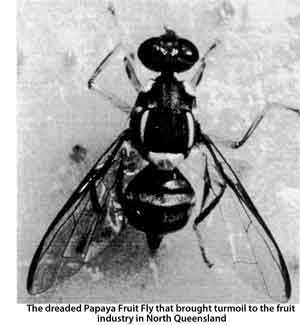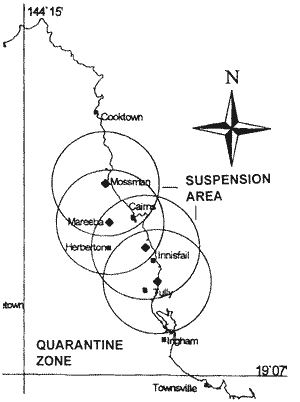
PAPAYA FRUIT FLY
Because of the high levels of damage the fruit fly can inflict on mango, citrus and papaya, and its tendency to attack fruit at a greener stage than the Queensland fruit fly, these are likely to require earlier applications of spray regimes and more intensive or regular treatments.
Papaya fruit fly can infest all edible fruit except pineapples, all vegetables except chokos, beans, peas, root vegetables such as potatoes, sweet potatoes and onions and leafy vegetables such as lettuce and cabbages.

WHAT DOES THE FRUIT FLY LOOK LIKE?
Papaya fruit fly is about the same length as a common house fly but more slender. It grows to 7mm in length and has clear wings, generally black chest and a paler abdomen, with a distinctive black T-shaped marking on the back.
The Queensland fruit fly, by comparison, is much the same size but is an overall reddish-brown colour.
Adult females lay their eggs just under the skin of fruit. Within two to three days the eggs hatch into maggots (larvae) which damage the fruit by burrowing into healthy plant tissue as they feed, causing decay and frequently premature fruit drop.
It takes 14 days for the larvae to leave the fruit to develop into pupae in the soil, and considerable damage can occur inside the flesh before obvious signs of infection can be seen on the fruit. The most obvious signs of infestations are small discoloured patches, or 'stings', made by the female as she lays her eggs.
The adults emerge from the pupa in another 14 days and become sexually mature after about a week. They live for several months and are capable of reproducing throughout their lifespan. Like most tropical fruit fly species, papaya fruit fly multiplies rapidly and can quickly spread over large distances. It is capable of establishing in any of the mainland states of Australia.
INDUSTRY CONFRONTS CRISIS
Mr Gibbs said his government would pay all costs directly associated with supervision of treatment measures.

Far north Queensland's papaya fruit fly crisis was continuing to worsen. The discovery of the fly in Bingil Bay prompted the Fruit Fly Taskforce to extend the north Queensland Quarantine zone from Cardwell to near Rollingstone, about halfway between Ingham and Townsville.
Len Collins, QFVG board member, said, while temporary dipping would get fruit moving again, longer term requirements were going to be a major expense for growers. "However I believe the banana industry will be able to develop protocols based on management in the field, that will eliminate the need for dipping within 12 months."
Ray Olufson, Mango chairman, said north Queensland mango growers appeared to have some time to meet the quarantine requirements before the harvest began in December.
Noel Stevenson, Pawpaw chairman, said growers were starting to work out how to handle the protocol requirements and, thanks to the DPI, were "pretty well aware of what they have to do". Many sheds already had their Q numbers registered.
Peter Brittain, Lychee chairman, said his growers' main concern was whether DPI would be able to register sheds and train inspectors in time for the opening of the season in two, three weeks time. There was also concern that the requirement for dipping to be the last fruit treatment before packing would affect quality. The good news for his grower members was that it appeared their newly-won export markets in Europe and Asia would not require dipping of fruit.
RESEARCH ALREADY WELL UNDER WAY
The good news, if there is any, from the fruit fly crisis in far north Queensland is that, thanks to Australia's involvement in and assistance with overseas agricultural research, we know quite a bit about the new pest.
DPI entomologists have been working on fruit fly research in Malaysia and Thailand since 1986, under the auspices of the Australian Centre for International Agricultural Research (ACIAR).
They have bred papaya fruit fly from 50 plant families and over 160 fruit species in those countries. As a result of this pest's heavy infestation habits, DPI will have to develop field control strategies for producers.
In the world scene, papaya fruit fly is endemic in Thailand, Indonesia, Malaysia and Singapore.
It entered Papua New Guinea in 1992. In March 1993, it was detected for the first time in Australian territory on the islands of Saibai, Boign and Dauan, adjacent to the PNG coast, and on Stephen and Darnley Islands, close to the centre of Torres Strait. Successful eradication programs have been carried out on Stephen and Darnley Islands.
Since then most of the inhabited islands of Torres Strait and the northern tip of Cape York Peninsula have been regularly monitored by trapping.
This program has shown that the fly has never entered Cape York at the northern extremity.
DPI Farmfax
Papaya Fruit Fly Facts Sheet can be accessed by phoning 07 3 222 2996. Instead of requesting the complete index, ask for the following item numbers:
120 Papaya Fruit Fly - a major new pest of horticulture
121 Papaya Fruit Fly - traps, samples and identification.
DATE: January 1992
* * * * * * * * * * * * *
